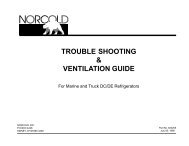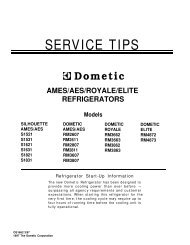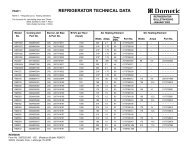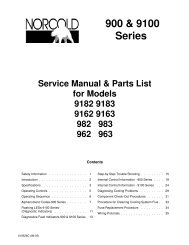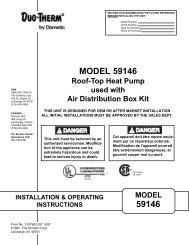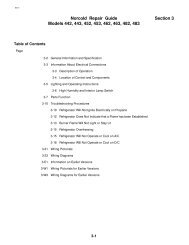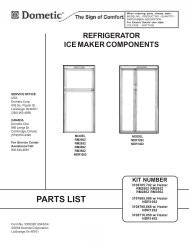service manual for 6700, 7000, 8000 & 9000 series air conditioners
service manual for 6700, 7000, 8000 & 9000 series air conditioners
service manual for 6700, 7000, 8000 & 9000 series air conditioners
- No tags were found...
You also want an ePaper? Increase the reach of your titles
YUMPU automatically turns print PDFs into web optimized ePapers that Google loves.
5. Suction LineThe suction line is the tube which carries the superheatedvapor refrigerant from the evaporator to the compressor.6. CompressorThe compressor is called a hermetic compressor which meansthat it is completely sealed (welded together). It is, there<strong>for</strong>e,not internally field <strong>service</strong>able. Inside the compressorhousing are basically:a) an electric motor which drives the compressor,b) a pump which is designed to pump superheatedvapor only,c) a supply of special refrigeration oil. A small portionof the oil will circulate out through the system withthe refrigerant, but will constantly return to thecompressor with the refrigerant, so the compressorwill not run out of oil.7. Discharge LineThe discharge line carries the refrigerant out of thecompressor and to the condenser coil. Remember that as therefrigerant entered the compressor, it was superheated vapor.The refrigerant enters the compressor, where more heat isadded and is compressed into a smaller space. Therefrigerant, there<strong>for</strong>e, leaves the compressor highlysuperheated – so if the discharge line is hot to the touch(burns), don’t be surprised – it should be.8. Condenser CoilThe purpose of the finned condenser coil is to transfer heatfrom the high pressure refrigerant to the warm outdoor <strong>air</strong>.As the outdoor <strong>air</strong> passes over the coil, the heat transfer willcause the <strong>air</strong> temperature to rise. Thus the condenserdischarge <strong>air</strong> will be several degrees warmer than thecondenser entering <strong>air</strong>.As the refrigerant passes through the first few tubes of thecondenser, its temperature will be lowered or it will be desuperheated.After the refrigerant is de-superheated, it willbegin to condense or change from a vapor to a liquid and willremain at a nearly constant temperature throughout almost allof the remainder of the coil. This temperature is called thecondensing temperature or high side saturation temperatureand will always be higher than the condenser entering <strong>air</strong>temperature.Near the bottom of the condenser, the refrigerant will all becondensed to a liquid and from there on its temperature willdrop to more nearly the temperature of the outdoor <strong>air</strong>. Afterthe temperature of the refrigerant drops below condensing orsaturation temperature, we call its condition sub-cooledliquid.During all of the three processes in the condenser (desuperheating,condensing, sub-cooling), the refrigerant givesup heat; but most of the heat is given up during thecondensing process.II. AIR HANDLING CIRCUITS1. Motors and FansOne motor turns both the condenser fan blade and evaporator<strong>air</strong> blower. The condenser (outdoor) fan is an axial flow(propeller) type and the evaporator (indoor) fan or blower is acentrifugal (squirrel cage) type.2. FiltersThe filters should always be in place when the system isrunning. More important than their purpose of cleaning the<strong>air</strong> in the living space is the protection the filters give theevaporator coil. Without filters, a wet evaporator coil willquickly stop up so that adequate <strong>air</strong> cannot pass through it.Filters must be installed to completely fill the filter rack sothat no <strong>air</strong> can flow around them or by-pass them and carrydust, lint, etc. to the evaporator. To clean an evaporator thathas not been properly protected by its filter, the entire unitmust be removed from the recreational vehicle and the coilcleaned with special detergent and water.III. ELECTRIC POWER CIRCUITS1. SafetyVoltage (electrical pressure), whether high or low, will nothurt you. It is the current through vital parts of your bodythat does the damage, and under the right conditions, 115volts (domestic USA) is plenty to drive a deadly dose ofcurrent (amperes) through your body.Another imminent danger from electric shocks in addition toelectrocution is reaction. An electrical shock causesuncontrollable muscular contractions which can cause furtherinjuries.Remember that electricity can be very dangerous, but you cansafely work with it. In order to be safe, you must know whatyou are doing. You must work deliberately and carefully.You must think safety be<strong>for</strong>e each move.THINK SAFETY2. Power Supply - from Commercial Utility1) Wire Size6



